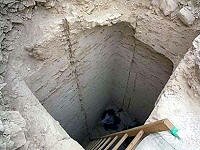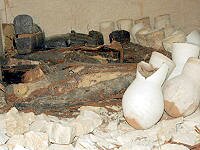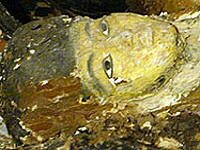|
|
|||||||||||||||||
|
|
egypt's "new" tomb For best results we recommend you maximise this browser window STOP PRESS: Friday 10th February 2006: New tomb opened in the Valley of the Kings! Archaeologists have discovered an intact, ancient Egyptian tomb in the Valley of the Kings, the first since King Tutankhamun's was found in 1922. A University of Memphis-led team found the previously unknown tomb complete with sarcophagi and five mummies. The archaeologists were working last year on the neighbouring tomb of Amenmeses, a late 19th dynasty pharaoh, when they found the remains of ancient workmen's huts. The scientists then discovered a depression in the bedrock that they suspected was a shaft. When they returned to work during this excavation season, they opened the shaft and found the door to the chamber.
STOP PRESS: Thursday 29th June 2006: Ancient garland in Egyptian tomb! Archaeologists in Egypt expecting to find a mummy during their excavation of a burial chamber in Luxor have instead discovered embalming materials and ancient woven flowers. The 3,000-year-old garland is the first to be discovered. It was found in the last of the coffins which archaeologists had hoped would contain the mummies of royal queens or even Tutankhamun's mother.
Hushed researchers had craned their necks and media scuffled inside the stiflingly hot underground stone chamber as Egyptian antiquities chief Zahi Hawass had slowly cracked open the coffin's lid - for what scientists believe is the first time in more than 3,000 years. But instead of a mummy, as archaeologists had expected, the coffin revealed a tangle of fabric and rusty coloured dehydrated flowers woven together in laurels that looked likely to crumble to dust if touched. Researchers and media had been invited into the chamber, near Tutankhamun's tomb, to watch the coffin's opening. The chief curator of Cairo's Egyptian Museum said the surprise find was "even better" than discovering a mummy. "I prayed to find a mummy, but when I saw this, I said it's better - it's really beautiful," said Nadia Lokma, the chief curator. "It's very rare - there's nothing like it in any museum. We've seen things like it in drawings, but we've never seen this before in real life - it's magnificent," she said. Experts say ancient Egyptian royals often wore garlands entwined with gold strips around their shoulders in both life and death. Since the discovery of the tomb, the lids of seven of the coffins - including a tiny one built for an infant and filled with feather-stuffed pillows - were removed one by one, revealing pottery shards and fabric, but no mummies. With the last one now opened, the tomb still held more mysteries than answers. It is now hoped that the hieroglyphs would help scientists identify who the coffins and tomb were made for and what had happened to the bodies. Courtesy of BBC News and National Geographic
|
||||||||||||||||
|
|||||||||||||||||



